Our son-in-law, Christopher, is a writer of plays and essays. When he comes to stay in our Maine house with our daughter and their son, it is difficult for him to write as it is not easy for him to find a place to be away from the distractions of family. Last year (2010) it was suggested that we might build a writing shed so he could have a place to retreat to. Many writers have had their sheds in which to write: Thoreau, Dylan Thomas, Virginia Woolf, Roald Dahl, Shaw. More recently Michael Pollan has written about his experiences of building his own writing shed in the book: A Place of My Own.
Back in February of this year (2011) I wrote to our daughter, Eliza:
"Maybe this summer we should build a small writing shed in the woods for Christopher? Maybe 10x10 or 10 x 12. Solar electric to run his computer. Simple. Shouldn't cost much and would be fun to build."
She wanted to know if I was serious; if so, Christopher would love it. I suggested we build it in the woods away from the house or across the road near Trues Pond.
I always interested in architecture and design. The idea of designing a small, simple shed was an intriguing idea. It couldn’t be too difficult; four walls, a door, windows here and there and maybe a single sloping roof.
Eliza did some research online. Here are some of her finds:
 Mandrup house in Denmark, Dorte Mandrup Arkitekter, photo by Torben Eskerod and Thomas Mandrup-Poulsen
Mandrup house in Denmark, Dorte Mandrup Arkitekter, photo by Torben Eskerod and Thomas Mandrup-Poulsen
 Krill architects Harmen van de Wal and Bart Goedbloed of the Netherlands. Photo by Jacqueline Schellingerhout
Krill architects Harmen van de Wal and Bart Goedbloed of the Netherlands. Photo by Jacqueline Schellingerhout
 John and Tammy Everts, British Columbia, Photo by Tammy Everts
John and Tammy Everts, British Columbia, Photo by Tammy Everts
Not exactly what I was interested in. I wanted something that would be more Maine-like.
The program as requested by Eliza and Christopher:
Skylight or a ceiling that lets in light
Screen windows/door/walls
Outlet for computer/light/printer/coffeemaker
Shelves
Later they added:
outhouse
built ins
lots of natural light
cross ventilation and no bugs
Away from the stream and into the woods.
A writing bench on one side and a bunk on the other.
Sounds more like a cabin rather than a writer's shed. It would be good to have a bunk where one could nap though.
Well that's not too demanding. One problem would be electricity. A cable rated for outdoor use, either above or under the ground, could be used. Cables usually come in 250' coils, so if the site were not further than that from the barn, electricity would be doable. Putting it underground would require a bit of digging and after it was buried, it might be difficult to locate it later. Although I don't foresee digging much in that area, there is the possibility that someone might dig into the wire with sad results.
The first sketch:
 Pretty crappy drawing but it does show what I was thinking. It has a sliding barn type door - easier to open when the snow is deep, but since this would be used in the warmer months a sliding door is unnecessary. Also noted is a ventilating skylight and a small wood stove. The boarded walls without siding-now that's not very practical-but cheap and easy to build.
Pretty crappy drawing but it does show what I was thinking. It has a sliding barn type door - easier to open when the snow is deep, but since this would be used in the warmer months a sliding door is unnecessary. Also noted is a ventilating skylight and a small wood stove. The boarded walls without siding-now that's not very practical-but cheap and easy to build.
My criteria were:
Maine like.
No plywood or particleboard.
No pressure treated wood.
Eliza's found online Michael Pollan's cabin, the one that he wrote about in A Place of My Own.
Now this is more like it.
The budget was $2000 not including material that we already had on hand: a skylight, various boards, and windows that were left over from a previous project.
Choosing the site.
Christopher had a preference for the woods. Our wooded land angles up behind a neighbor who often works in metal, and the noise from his grinding and hammering might be a distraction. We looked to be away from the neighbor and far enough from our house and barn that Christopher could feel secluded.
The woods are full of small rises with wet areas often in between them so the natural choice would be on one of the small rises away from the neighbor and within 200 feet of the barn (in order to have electricity). In early June, Eliza and Christopher ventured out and they chose a spot:
 Christopher demonstrating his new writing space.
Christopher demonstrating his new writing space.
Earlier I had been in touch with Gary Littlefield of Belfast. He builds sheds at his yard with lumber that he cuts and mills himself. His prices are quite reasonable, but there were limitations to what he could do. There was no way he could haul a completed shed back into the site without a road built. Also due to highway regulations and the limits of his trailer, the walls of the shed could only be six feet in height with a maximum roof pitch of 5/12. A 5/12 pitch means that over the horizontal distance of 12 inches, the rise of the roof is 5 inches. For aesthetic reasons I wanted a 10/12 pitch or even a 12/12 pitch. The pitch of the ell over our kitchen is a 9/12 pitch that looks OK-I would have settled for that. Pollan's shed is 12/12.
A six foot high wall would make the maximum door height 5' 9". Ducking would be necessary when entering-not acceptable.
There is a shed building company in Warren called Shed City. Their sheds are attractive but are expensive and built out of regular 2x4's and plywood sheathing. For an 8x12 shed with one single hung window, a door, cedar shingle siding and an asphalt roof, the cost would be $3450 plus tax. But then, they would have the same problem of moving it into the woods.
The plan was that I was to come up from Philadelphia for ten days and with the help of Steve Staples, a carpenter from Linconville, and we would build the shed. Christopher, who had no experience in construction, would help where he could.
I ordered the posts and beams of rough sawn spruce and hemlock from Viking Lumber in Belfast. It was delivered on Monday the 13th.
On the way up to Maine, the car's radiator broke on the Massachsettes turnpike near Auburn. It was Saturday, and the part was not available until Monday. So I rented a car, drove to Maine that afternoon and back again on Monday to pick it up- a 500 mile round trip.
Steve Staples came over the next day to look over the situation and agreed that we would start on Wednesday afternoon as he had another commitment that morning. Christopher and I would find flat rocks for the foundation before he arrived on Wednesday afternoon. I brought out the electricity from the barn. Christopher lugged most of the beams back to the site.
Day one: Wednesday afternoon, June 15.
We laid out floor joists and Steve screwed them together
 Steve checking the level with Christopher and Eamon's approval
Steve checking the level with Christopher and Eamon's approval
At 7:30 am Gary Littlefield brought the boarding boards - ten inches wide or better, some over 13" wide - all 12' long. We lay the floor and put up the walls. We decided to lay plastic between the floor and the floor joists and the floor as a mosquito barrier not thinking that if the floor should get wet, the moisture would be trapped below the floorboards and warp them. Our first mistake.
 Working with Steve is pretty enjoyable. He's always making fun of me, saying that I am either not working hard enough or disappearing. As he is only two years younger than I (71). He suggested that together we form the Old Fart Construction Company. It is amazing how well he gets around considering his age and the fact that he shattered his knee in a snowmobiling accident a while back.
Working with Steve is pretty enjoyable. He's always making fun of me, saying that I am either not working hard enough or disappearing. As he is only two years younger than I (71). He suggested that together we form the Old Fart Construction Company. It is amazing how well he gets around considering his age and the fact that he shattered his knee in a snowmobiling accident a while back.
 His dog Wheeler is always with him. Wheeler seems to be immune to the noise of hammers and nail guns. He usually digs a hole under the shed where he sleeps while we work.
His dog Wheeler is always with him. Wheeler seems to be immune to the noise of hammers and nail guns. He usually digs a hole under the shed where he sleeps while we work.
Today we boarded up the walls, set the end rafters and put up the ridge pole. Steve and I had a difference of opinion. He thought that a 10 or 12 pitch roof was too steep. He was inclined to use a 5 pitch. "It will look like a steeple!" I decided on a 10 pitch.
Saturday & Sunday
As Steve had the weekend off, I put up rest of the rafters; finished framing out the end wall and put up additional boards where they were needed.
 Topping out with a small pine tree.
Topping out with a small pine tree.
Monday, June 20
Today we boarded the roof and finished boarding the end walls. Em put Typar on the walls. Steve calls Typar "Maine siding."
Tuesday, June 21
I drove to Viking and picked up the trim boards. I decided to get a #2 grade pine but them seemed better than a #2 grade as almost all of them were free of knots. I was back by the time Steve arrived to work at 8. It took him all day to trim one end wall and the boards under the eaves. I am not complaining as they are nicely fitted. The shed is true and square. There is only a 1/16" difference in length from one side to the other. It's starting to look like something!
This is our last workday, as we have to go back to Philadelphia tomorrow. We try to get the building in a useable condition for Christopher. To do that we have to make it somewhat water and bug resistant. I have ordered the window that will go over the table/workbench from Eliason in Madison who had promised it to be ready by tomorrow. But, since we haven't heard from him, it doesn't look like it will be done in time. So the plan is to put screening over the window as a temporary measure until the window can be installed. Also the door has to be fitted and installed. Much to do.
The decision was made to put in one of the skylights I bought at Home Depot on sale a few years back. The Velux is of the opening variety but it proved too be large for the roof. The other one, an Anderson, is non-opening and smaller so we went with that. As we had not framed the rafters to accommodate the skylight, it was going to take a little longer to install.
 Steve evens out the boarding boards where the skylight will go.
Steve evens out the boarding boards where the skylight will go.
In the afternoon Steve finished the trim. I made and installed the doorjamb and threshold. A cheap screen door from Home Depot needed to be shortened to fit and was warped to boot. I'll have to make one from scratch when I come back in July.
Steve and I put tar paper on the roof to keep most of the rain out.
Thursday, June 22
 We plan to leave by 11, so there is some time to install the door. I am using the hinges from the old outhouse that require driving the hinge pin into frame of the door. Even after drilling where the pin will go, the pins go in hard using the splitting maul.
We plan to leave by 11, so there is some time to install the door. I am using the hinges from the old outhouse that require driving the hinge pin into frame of the door. Even after drilling where the pin will go, the pins go in hard using the splitting maul.
 About 15 years ago I bought from Ralph True a bunch of wide pine boards. One of the boards is two inches thick, 20 inches wide and nearly eight feet long. Perfect for Christopher's writing surface.
About 15 years ago I bought from Ralph True a bunch of wide pine boards. One of the boards is two inches thick, 20 inches wide and nearly eight feet long. Perfect for Christopher's writing surface.
 I screen the front opening where the window above the writing surface will go so Christopher will be able to use the shed even though it is not finished.
I screen the front opening where the window above the writing surface will go so Christopher will be able to use the shed even though it is not finished.
 Done for now. We drive to Philadelphia.
Done for now. We drive to Philadelphia.
 The cost so far is just under $2000 not including the free labor and materials on hand.
The cost so far is just under $2000 not including the free labor and materials on hand.
Thursday July 7
Although the shed was not finished, Christopher was able to use it until they packed up and left for Brooklyn a week ago. Today construction resumed. We installed the large window over the writing deck. It was custom made by Elias Woodworking in Madison, Maine. George Elias has a one man shop that specializes in custom made windows and sash. The business was started by his father 45 years ago.
Today Steve with his helper Chris Rolfe, started to wood shingle the roof. They only got this this much completed today as Steve had an appointment this afternoon and Chris had to pick up his kids from Montessori school in Belfast.
 Chris and Steve finishing up the days' work.
Chris and Steve finishing up the days' work.
Friday July 8
Today Steve and Chris finished the front of the roof (it still needs the ridge boards) and are about half way up the other side. It was also a short day.
Monday, July 11
Steve and Chris Rolfe finish up the roof.
With Emily's help, I finish shingling the outer walls by July 19th.
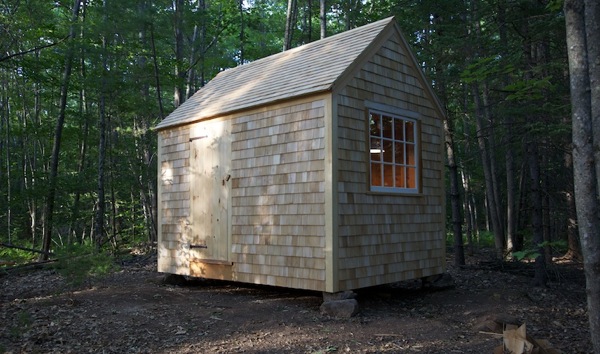
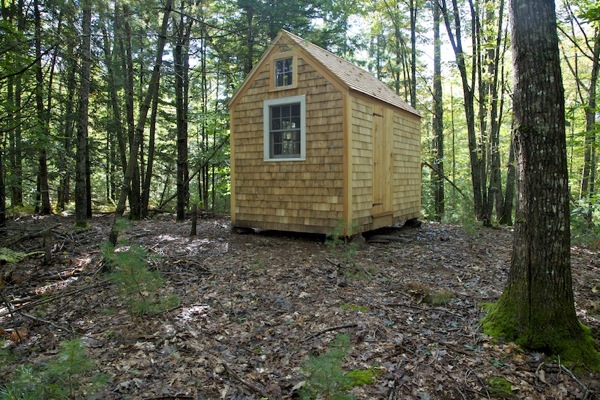
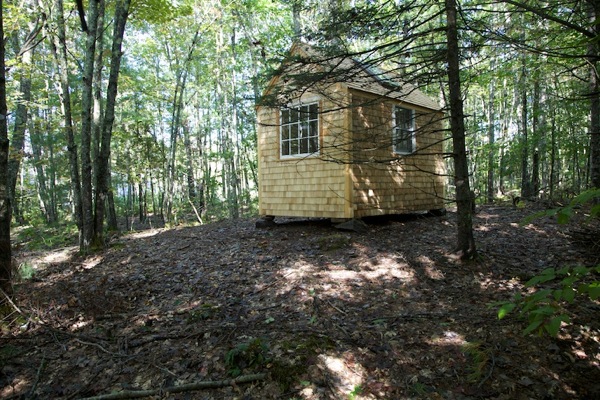
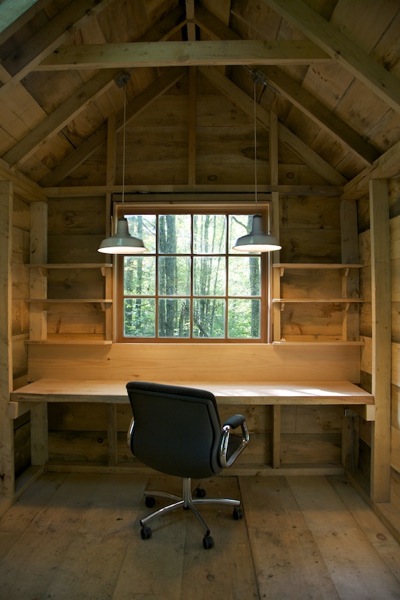
Lighting and bookshelves
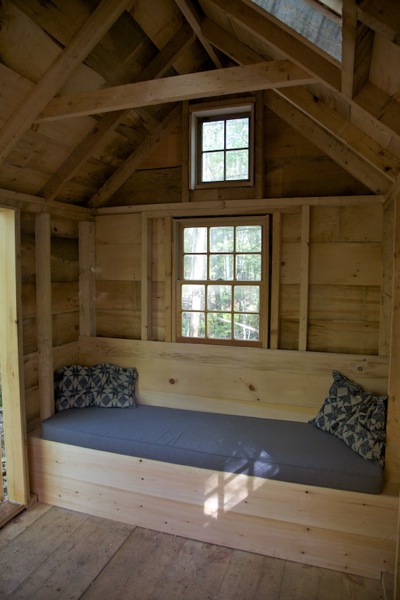
Every writer needs a place to nap now and again-it's part of the creative process.
Art's Canvas in Belmont provided the cushion. Emily made use of some old linsey-woolsey coverlets to cover the throw pillows.
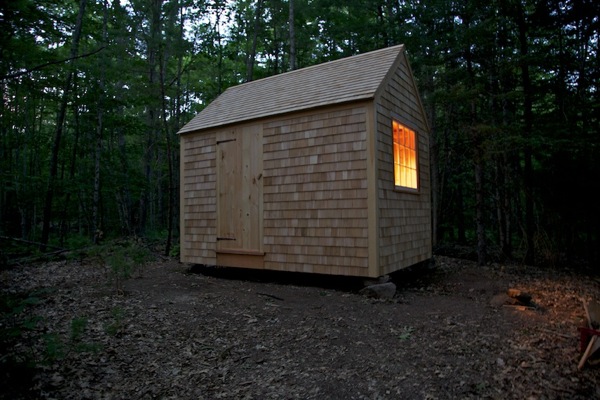
It pretty much done. We have to decide whether to paint the trim or let it weather to grey as the shingles will do. Two of the windows came pre-primed so maybe that answers the question. It would be nice to have the shed maintenance free, but I guess there is no such thing unless we had resorted to a vinyl door, windows and siding.
Besides the lack of screens for the door and the large window (to be done in the spring), one finishing detail remained-an entry step. We had a perfectly sized stone that was used in our now-demolished outhouse. As it weighed 300 pounds plus, it would not be an easy task to lug it through the woods. My friend Steve Sears was visiting and he took it upon himself to organize the project. Steve is an art metal fabricator and blacksmith and is used to moving large heavy objects as part of his business. After getting the step up and onto my tractor scoop, the problem was to drive the tractor trough the woods where a road did not exist. Needless to say, we did it, but not without a few anxious moments.
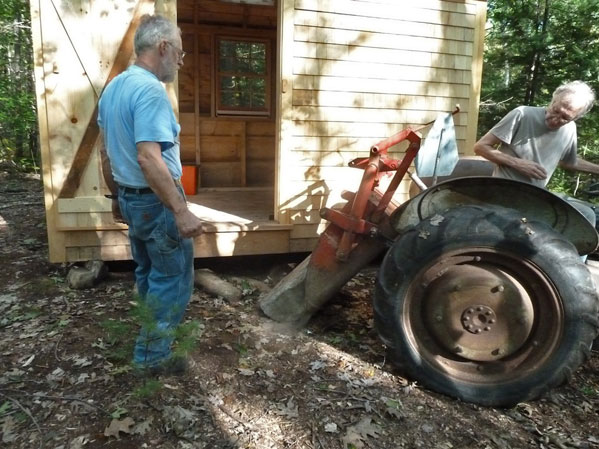

The step is in place-thanks Steve!
All in all it was a fun project. Our original budget of $2000 was exceeded by quite a bit. Material and paid labor came to a little over $3500. As mentioned above, this did not include the skylight; two of the windows that we on hand; some bits and pieces of lumber that were lying around and the free labor of Christopher, Emily and myself.






























